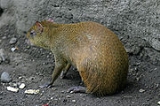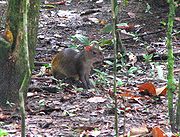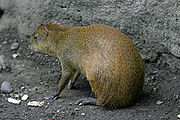
Central American Agouti
Encyclopedia
The Central American Agouti (Dasyprocta punctata) is an agouti
species
from the family Dasyproctidae
. The species is widespread in Mesoamerica and South America. The northern section of the range occurs from Chiapas
and the Yucatan Peninsula
(southern Mexico
) to northern Ecuador
and Colombia
and western Venezuela
. The southern portion of the range occurs from southern Peru and Bolivia, through southwestern Brazil and Paraguay
to northern Argentina
(Woods and Kilpatrick, 2005). It has been introduced to both eastern and western Cuba
and the Cayman Islands
(Woods and Kilpatrick, 2005). In Mesoamerica
, it can be found from lowlands to 2400 m (Reid, 1997).
 The body length of the agouti is 41.5 to 62 cm (16.3 to 24.4 in) and the tail is 1 to 3.5 cm (0.393700787401575 to 1.4 in). It weighs around 1.3 to 4 kg (2.9 to 8.8 lb). The Central American agouti is typically slender. They have short ears and the hind foot has three toes and have hoof-like claws (Nowak, 1999). Its coat varies from pale orange to different shades of brown or black and varies from white and yellow ventrally. Some have stripes, and the fur is coarse and glossy.
The body length of the agouti is 41.5 to 62 cm (16.3 to 24.4 in) and the tail is 1 to 3.5 cm (0.393700787401575 to 1.4 in). It weighs around 1.3 to 4 kg (2.9 to 8.8 lb). The Central American agouti is typically slender. They have short ears and the hind foot has three toes and have hoof-like claws (Nowak, 1999). Its coat varies from pale orange to different shades of brown or black and varies from white and yellow ventrally. Some have stripes, and the fur is coarse and glossy.
The gestation period is 90 to 126 days. They typically have 1–4 offspring, which weighs about 22.7 gram (0.800718939786042 oz) at birth, and mothers usually nurse young for about 140 days. Young reach maturity in about 487 days. Offspring typically become independent once a new litter is born due to aggression or lack of food. The average lifespan of an agouti is 13.80 years.
They mainly feed on fruits, and on excursions, they search for fruit bearing trees (Grzimek, 1990). They are able to hear fruit falling from trees from far away, which attracts them. When food is abundant they bury the seeds of many species of forest trees (Macdonald, 1984). Dasyprocta punctata also sometimes browsed and ate crabs, vegetables and other plants (Nowak, 1999).
 Agoutis spend much of their daily activities grooming with their forefeet. It is used as a comb. They remove parasites, ticks and mites. They are diurnal, but shift to night hours if there is much human predation around. They are endothermic, and live near water as a homeostatic strategy.
Agoutis spend much of their daily activities grooming with their forefeet. It is used as a comb. They remove parasites, ticks and mites. They are diurnal, but shift to night hours if there is much human predation around. They are endothermic, and live near water as a homeostatic strategy.
Common agouti
The popular term Agouti designates several rodent species of the genus Dasyprocta that inhabit areas of Middle America, the West Indies, and northern South America. They are related to guinea pigs and look quite similar but have longer legs. The species vary in color from tawny to dark brown with...
species
Species
In biology, a species is one of the basic units of biological classification and a taxonomic rank. A species is often defined as a group of organisms capable of interbreeding and producing fertile offspring. While in many cases this definition is adequate, more precise or differing measures are...
from the family Dasyproctidae
Dasyproctidae
Dasyproctidae is a family of large South American rodents, comprising the agoutis and acouchis. Their fur is a reddish or dark colour above, with a paler underside. They are herbivorous, often feeding on ripe fruit that falls from trees...
. The species is widespread in Mesoamerica and South America. The northern section of the range occurs from Chiapas
Chiapas
Chiapas officially Estado Libre y Soberano de Chiapas is one of the 31 states that, with the Federal District, comprise the 32 Federal Entities of Mexico. It is divided in 118 municipalities and its capital city is Tuxtla Gutierrez. Other important cites in Chiapas include San Cristóbal de las...
and the Yucatan Peninsula
Yucatán Peninsula
The Yucatán Peninsula, in southeastern Mexico, separates the Caribbean Sea from the Gulf of Mexico, with the northern coastline on the Yucatán Channel...
(southern Mexico
Mexico
The United Mexican States , commonly known as Mexico , is a federal constitutional republic in North America. It is bordered on the north by the United States; on the south and west by the Pacific Ocean; on the southeast by Guatemala, Belize, and the Caribbean Sea; and on the east by the Gulf of...
) to northern Ecuador
Ecuador
Ecuador , officially the Republic of Ecuador is a representative democratic republic in South America, bordered by Colombia on the north, Peru on the east and south, and by the Pacific Ocean to the west. It is one of only two countries in South America, along with Chile, that do not have a border...
and Colombia
Colombia
Colombia, officially the Republic of Colombia , is a unitary constitutional republic comprising thirty-two departments. The country is located in northwestern South America, bordered to the east by Venezuela and Brazil; to the south by Ecuador and Peru; to the north by the Caribbean Sea; to the...
and western Venezuela
Venezuela
Venezuela , officially called the Bolivarian Republic of Venezuela , is a tropical country on the northern coast of South America. It borders Colombia to the west, Guyana to the east, and Brazil to the south...
. The southern portion of the range occurs from southern Peru and Bolivia, through southwestern Brazil and Paraguay
Paraguay
Paraguay , officially the Republic of Paraguay , is a landlocked country in South America. It is bordered by Argentina to the south and southwest, Brazil to the east and northeast, and Bolivia to the northwest. Paraguay lies on both banks of the Paraguay River, which runs through the center of the...
to northern Argentina
Argentina
Argentina , officially the Argentine Republic , is the second largest country in South America by land area, after Brazil. It is constituted as a federation of 23 provinces and an autonomous city, Buenos Aires...
(Woods and Kilpatrick, 2005). It has been introduced to both eastern and western Cuba
Cuba
The Republic of Cuba is an island nation in the Caribbean. The nation of Cuba consists of the main island of Cuba, the Isla de la Juventud, and several archipelagos. Havana is the largest city in Cuba and the country's capital. Santiago de Cuba is the second largest city...
and the Cayman Islands
Cayman Islands
The Cayman Islands is a British Overseas Territory and overseas territory of the European Union located in the western Caribbean Sea. The territory comprises the three islands of Grand Cayman, Cayman Brac, and Little Cayman, located south of Cuba and northwest of Jamaica...
(Woods and Kilpatrick, 2005). In Mesoamerica
Mesoamerica
Mesoamerica is a region and culture area in the Americas, extending approximately from central Mexico to Belize, Guatemala, El Salvador, Honduras, Nicaragua, and Costa Rica, within which a number of pre-Columbian societies flourished before the Spanish colonization of the Americas in the 15th and...
, it can be found from lowlands to 2400 m (Reid, 1997).
Morphology

Reproduction and development
Central American agoutis are monogamous and mate with the each other for life. During courtship the male agouti sprays urine on the female, which causes her to go into a “frenzy” dance, which is necessary before mate acquisition (Smythe, 1978). They breed throughout the year, but majority of the young are born during fruit abundance (between March and July).The gestation period is 90 to 126 days. They typically have 1–4 offspring, which weighs about 22.7 gram (0.800718939786042 oz) at birth, and mothers usually nurse young for about 140 days. Young reach maturity in about 487 days. Offspring typically become independent once a new litter is born due to aggression or lack of food. The average lifespan of an agouti is 13.80 years.
Ecology
Agoutis are terrestrial and cursorial which means ground dwelling and built for running with speed. They walk, trot or gallop on their toes, and can jump up more than six feet from a standing position. They prefer tropical, terrestrial habitats. They also build small caves around sources of water. When their territory is challenged, males often get into fights.They mainly feed on fruits, and on excursions, they search for fruit bearing trees (Grzimek, 1990). They are able to hear fruit falling from trees from far away, which attracts them. When food is abundant they bury the seeds of many species of forest trees (Macdonald, 1984). Dasyprocta punctata also sometimes browsed and ate crabs, vegetables and other plants (Nowak, 1999).
Physiological attributes

Behavior
They use good vision, hearing and tactile communication through grooming. Also, males and females possess anal scent glands which they use to mark territory or various structures.External links
- Infonatura
- Decker, J. 2000. "Dasyprocta punctata", Animal Diversity Web. Accessed November 26, 2008

